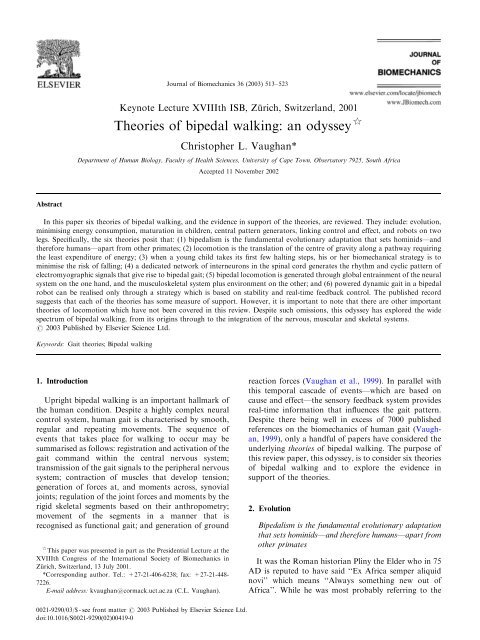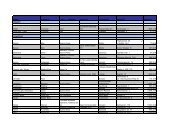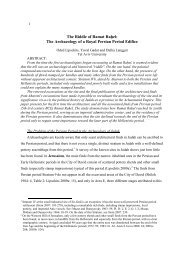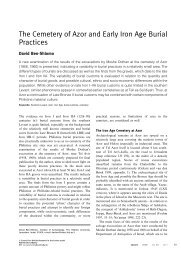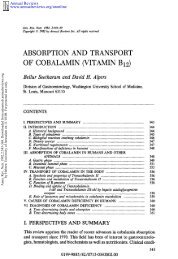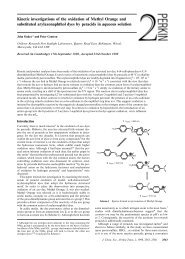Theories of bipedal walking: an odyssey
Theories of bipedal walking: an odyssey
Theories of bipedal walking: an odyssey
Create successful ePaper yourself
Turn your PDF publications into a flip-book with our unique Google optimized e-Paper software.
518C.L. Vaugh<strong>an</strong> / Journal <strong>of</strong> Biomech<strong>an</strong>ics 36 (2003) 513–523Risk Aversion Hypothesissingle limbst<strong>an</strong>ce timecadencestep widthstep lengthFig. 6. When learning to walk, young inf<strong>an</strong>ts adopt a biomech<strong>an</strong>ical strategy <strong>of</strong> minimising risk by maintaining a shorter step length, lower cadence,wider step width <strong>an</strong>d lower single-limb st<strong>an</strong>ce time (L<strong>an</strong>gerak et al., 2001). The gait parameters have been scaled according to H<strong>of</strong> (1996).BrainBrainIncomplete SCIComplete SCILocomotorCPGSCS20-60 Hz1-10 VLocomotorCPGTreadmillFig. 7. Stepping movements, providing evidence <strong>of</strong> a central pattern generator (CPG), c<strong>an</strong> be induced in patients with spinal cord injury (SCI) using:(a) mech<strong>an</strong>ical stimulation via a treadmill; <strong>an</strong>d (b) spinal cord stimulation or SCS (Pinter <strong>an</strong>d Dimitrijevic, 1999).conducted a study on six subjects with complete longst<strong>an</strong>dingSCI in which <strong>an</strong> electrical train <strong>of</strong> stimuli wereapplied epidurally over the second lumbar segment <strong>of</strong>the spinal cord (cf. Fig. 7b). This stimulation inducedrhythmic, alternating st<strong>an</strong>ce <strong>an</strong>d swing phases <strong>of</strong> thelower limbs (Dimitrijevic et al., 1998).Olree <strong>an</strong>d Vaugh<strong>an</strong> (1995) performed a principalcomponents (or factor) <strong>an</strong>alysis on the EMG patterns <strong>of</strong>16 muscles (eight bilateral pairs) in ten normal subjects.They established two primary factors, named loadingresponse <strong>an</strong>d propulsion, which correspond with import<strong>an</strong>tphases in the gait cycle (cf. Fig. 8). They alsodiscovered a third factor, which they called thecoordinating factor, that appeared to maintain the phaseshift between the left <strong>an</strong>d right legs. Their findingssuggest that the CNSsolves the problem <strong>of</strong> high
C.L. Vaugh<strong>an</strong> / Journal <strong>of</strong> Biomech<strong>an</strong>ics 36 (2003) 513–523 519Factor Score3210-1-2dimensionality by generating just a few fundamentalsignals which control all the major muscle groups inboth legs. There have been other recent studies utilisingEMG in both inf<strong>an</strong>ts <strong>an</strong>d adults that have providedsupport for the hypothesis that a single locomotor CPGcontrols both forward <strong>an</strong>d backward <strong>walking</strong> (Lamb<strong>an</strong>d Y<strong>an</strong>g, 2000; v<strong>an</strong> Deursen et al., 1998).6. Linking control <strong>an</strong>d effectPropulsion FactorFactor 3Factor 40 20 40 60 80 100% Gait CycleFig. 8. Eigenvectors, or factor <strong>an</strong>alysis scores, plotted as a function <strong>of</strong>the gait cycle (Olree <strong>an</strong>d Vaugh<strong>an</strong>, 1995). Factors 3 <strong>an</strong>d 4 are thepropulsion factors <strong>an</strong>d correspond closely to the electromyographicsignals <strong>of</strong> the left <strong>an</strong>d right gastrocnemius muscles, respectively.Bipedal locomotion is generated through global entrainment<strong>of</strong> the neural system on the one h<strong>an</strong>d, <strong>an</strong>d themusculoskeletal system plus environment on the otherCharles Scott Sherrington, who won a Nobel Prize forhis contributions to neuroscience in 1932, said ‘‘Swiftlythe brain becomes <strong>an</strong> ench<strong>an</strong>ted loom, where millions <strong>of</strong>flashing shuttles weave a dissolving pattern, always ame<strong>an</strong>ingful pattern though never <strong>an</strong> abiding one; ashifting harmony <strong>of</strong> sub-patterns’’ (Sherrington, 1941).This <strong>an</strong>alogy between the functioning <strong>of</strong> the brain <strong>an</strong>d amachine was a mathematical construct described almost60 years ago by McCulloch <strong>an</strong>d Pitts (1943). Theypioneered the field <strong>of</strong> artificial neural networks (ANNs)<strong>an</strong>d, although there was some activity in the 1960s(Rosenblatt, 1961; Minsky <strong>an</strong>d Papert, 1969), ANNsonly became widely accepted as <strong>an</strong> area <strong>of</strong> seriousresearch endeavour during the 1980s with the efforts <strong>of</strong>Hopfield (1982), Anderson (1983), Rumelhart et al.(1986) <strong>an</strong>d others. As the name implies, <strong>an</strong> ANN is agroup <strong>of</strong> m<strong>an</strong>y neurons (or processing elements) that areinterconnected <strong>an</strong>d distributed in layers. An ANNnormally operates in two states: learning, where aprocess <strong>of</strong> ch<strong>an</strong>ges in the synaptic weights occurs; <strong>an</strong>drecall, where <strong>an</strong> input stimulus generates <strong>an</strong> outputsignal (Rumelhart et al., 1986).While ANNs were originally utilised in patternrecognition problems, their application to the study <strong>of</strong>real biological systems beg<strong>an</strong> to appear in the early1990s (Srinivas<strong>an</strong> et al., 1992. Sepulveda et al., 1993).The argument had thus come full circle: ANNs, inspiredby the example <strong>of</strong> the central nervous system, now hadthe potential to help elucidate how the CNSitselffunctioned (Vaugh<strong>an</strong>, 1997). Sepulveda et al. (1993)built <strong>an</strong> ANN in which 16 EMG signals were used as theinput signals <strong>an</strong>d three joint torques were generated asoutput. Once the network had been successfully trained,a series <strong>of</strong> simulations were conducted. A 30% reductionin the magnitude <strong>of</strong> the soleus EMG led to a signific<strong>an</strong>treduction in the pl<strong>an</strong>tar flexor moment at the <strong>an</strong>kle joint(cf. Fig. 9), a prediction that is consistent with ourunderst<strong>an</strong>ding <strong>of</strong> <strong>an</strong>kle biomech<strong>an</strong>ics. Recognising thepotential <strong>of</strong> ANNs to control muscle activation patterns,Popovic et al. (1993) developed a network whichthey tested on chronic spinalised cats. Other researchershave built on this basic science platform <strong>an</strong>d have usedANN models <strong>an</strong>d functional electrical stimulation torehabilitate the gait <strong>of</strong> hum<strong>an</strong> subjects (Graupe <strong>an</strong>dKordylewski, 1995; Sepulveda <strong>an</strong>d Cliquet, 1995).While the aforementioned models linked the controller(neural system) <strong>an</strong>d the effector (mech<strong>an</strong>icalsystem), they lacked true integration with feedbackinfluencing the real-time perform<strong>an</strong>ce <strong>of</strong> the model(Vaugh<strong>an</strong>, 1997). One <strong>of</strong> the most intriguing models <strong>of</strong><strong>bipedal</strong> <strong>walking</strong> is that developed by Taga et al. (1991).A pair <strong>of</strong> CPGs, modelled by <strong>an</strong> ANN, controlled themuscles <strong>of</strong> the trunk plus the left <strong>an</strong>d right hip, knee <strong>an</strong>d<strong>an</strong>kle joints. Their biped consisted <strong>of</strong> eight segments, 10degrees <strong>of</strong> freedom <strong>an</strong>d 19 muscle actuators. A series <strong>of</strong>Fig. 9. An artificial neural network, designed to link 16 electromyographicsignals <strong>an</strong>d three joint moments, predicts the effect <strong>of</strong> a 30%reduction in the soleus activity (cf. dashed line), showing a signific<strong>an</strong>tdecrease in the pl<strong>an</strong>tar flexor moment at the <strong>an</strong>kle during the push-<strong>of</strong>fphase (Sepulveda et al., 1993).
520C.L. Vaugh<strong>an</strong> / Journal <strong>of</strong> Biomech<strong>an</strong>ics 36 (2003) 513–523Higher Centreu 0Neural Rhythm Generator•u = q(u)MotorSensoryComm<strong>an</strong>dSignalT r (u) S e (ϕ,F g )(b)Musculo-Skeletal System•ϕ = p(ϕ,F g )(a)ϕEnvironmentF g(c)Fig. 10. (a) A model <strong>of</strong> the locomotor system links control <strong>an</strong>d effect with coupled differential equations (Taga, 1995). Global entrainment <strong>of</strong> theneural system on the one h<strong>an</strong>d, <strong>an</strong>d the musculoskeletal system plus environment on the other, generates <strong>bipedal</strong> gait on (b) the level <strong>an</strong>d c<strong>an</strong> adapt to(c) <strong>an</strong> uphill pathway.coupled differential equations defined both the neuralrhythms (CPGs) <strong>an</strong>d the mech<strong>an</strong>ics <strong>of</strong> the musculoskeletalsystem (cf. Fig. 10a). Once the model had beentrained, it not only produced level gait under normalconditions (cf. Fig. 10b), but it also adapted to environmentalperturbations such as uneven terrain or increasedcarrying load (cf. Fig. 10c). Taga (1995) demonstratedthat the speed <strong>of</strong> <strong>walking</strong> could be controlled by a singleparameter which drove the neural oscillators, <strong>an</strong>d thestep cycle could be entrained by a rhythmic input to theoscillators.7. Robots on two legsPowered dynamic gait in a <strong>bipedal</strong> robot c<strong>an</strong> berealised only through a strategy which is based onstability <strong>an</strong>d real-time feedback controlFive decades ago Isaac Asimov, the science fictionwriter (who also held a doctorate in chemistry)formulated his three laws <strong>of</strong> robotics. The second <strong>of</strong>these stated that ‘‘A robot must obey the orders given itby hum<strong>an</strong> beings’’. One <strong>of</strong> these orders would no doubthave been to walk, a natural extension <strong>of</strong> the originalfunction <strong>of</strong> a ‘‘robot’’, first introduced to the Englishl<strong>an</strong>guage by the playwright Karel Capek in 1921. Basedon his mother tongue <strong>of</strong> Czech, a robota is defined as aworker <strong>of</strong> forced labour. Over 30 years before Capekcoined the term robot, George Fallis in the USAinvented a <strong>bipedal</strong> <strong>walking</strong> toy (Fallis, 1888). Thecentral claim <strong>of</strong> his patent stated ‘‘This inventionconsists <strong>of</strong> a toy which is designed to simulate thehum<strong>an</strong> frame <strong>an</strong>d which is a combined pendulum <strong>an</strong>drocker construction, whereby when placed upon <strong>an</strong>inclined pl<strong>an</strong>e it will be caused by the force <strong>of</strong> its owngravity to automatically step out <strong>an</strong>d walk down thesaid pl<strong>an</strong>e’’ (cf. Fig. 11).What Fallis had described was a passive <strong>bipedal</strong>robot, where the word ‘‘passive’’ connotes the lack <strong>of</strong>active power. Another feature <strong>of</strong> the Fallis walker wasthat its gait was almost certainly static, in the sense thatits centre <strong>of</strong> gravity was always located within its base <strong>of</strong>support. This is in contrast to dynamic <strong>walking</strong> wherethe centre <strong>of</strong> gravity falls outside the support baseduring the tr<strong>an</strong>sition from one foot to the other. Thepassive vs. active debate is <strong>an</strong> interesting one, as is thediscourse on static vs. dynamic gait. A little over 10years ago McGeer (1990) demonstrated that a passivewalker based on the Fallis design, despite the lack <strong>of</strong> <strong>an</strong>yform <strong>of</strong> feedback control, could achieve dynamic gait.His work has led to more recent efforts to explore thepotential <strong>of</strong> passive gait to provide biomech<strong>an</strong>icalinsight (Garcia et al., 1998; Kuo, 2001). The firsttheoretical attempts to describe the mech<strong>an</strong>ics <strong>of</strong> <strong>an</strong>active <strong>bipedal</strong> robot were made over 30 years ago(McGhee, 1968; Vukobratovic, 1970; Fr<strong>an</strong>k, 1970). Agroup at Waseda University in Jap<strong>an</strong>, led by Kato et al.(1974), are generally acknowledged to have been the firstto design <strong>an</strong>d implement a successful active walker.However, it employed a static gait pattern, with active<strong>walking</strong> in a <strong>bipedal</strong> robot only being achieved in thelate 1980s (Zheng, 1989).The most recent breakthroughs in implementingactive dynamic gait in <strong>bipedal</strong> robots have been madeby the Jap<strong>an</strong>ese comp<strong>an</strong>ies Honda (2002) <strong>an</strong>d Sony(2002). Both Honda’s ASIMO (mass 43 kg, height 1.2 m,velocity 0.44 m/s) <strong>an</strong>d Sony’s SDR-3X (mass 5 kg,height 0.5 m, velocity 0.25 m/s) are <strong>an</strong>thropomorphic
C.L. Vaugh<strong>an</strong> / Journal <strong>of</strong> Biomech<strong>an</strong>ics 36 (2003) 513–523 521Fig. 11. The first three drawings <strong>of</strong> the patent by Fallis (1888) demonstrating how a <strong>bipedal</strong> toy is able to walk when powered only by gravity.Reproduced with the permission <strong>of</strong> the United States Patent <strong>an</strong>d Trademark Office. I am indebted to Andy Ruina <strong>of</strong> Cornell University whoseresearch group made the patent available on their web-site.Fig. 12. Two <strong>an</strong>thropomorphic <strong>bipedal</strong> robots, each with 24 degrees <strong>of</strong> freedom, that demonstrate powered dynamic gait utilising real-time feedbackcontrol: (a) ASIMO m<strong>an</strong>ufactured by Honda (2002); <strong>an</strong>d (b) SDR-3X m<strong>an</strong>ufactured by Sony (2002). Both photographs have been reproduced withthe permission <strong>of</strong> the respective comp<strong>an</strong>ies.robots with 24 degrees <strong>of</strong> freedom (cf. Fig. 12). Bothhave joint torque actuators, sophisticated feedback viaaccelerometers <strong>an</strong>d rate sensors, plus <strong>an</strong> onboardcomputer to provide real-time control. As is evidentfrom videos <strong>of</strong> the robots, their gait—which includesstair climbing—is not only stable but very similar to that<strong>of</strong> hum<strong>an</strong>s whom they have been designed to mimic. Tobe sure, robots on two legs have come a long way sinceFallis’ invention in the late 19th century.8. Concluding remarksThere are, <strong>of</strong> course, other import<strong>an</strong>t theories <strong>of</strong>locomotion that have not been considered in this review.These include: the dynamic similarity hypothesis, wherethe Froude number—the dimensionless ratio <strong>of</strong> velocitysquared to the product <strong>of</strong> leg length <strong>an</strong>d the accelerationdue to gravity—is const<strong>an</strong>t (Alex<strong>an</strong>der <strong>an</strong>d Jayes, 1983);the theory <strong>of</strong> the spinal engine, which posits that thelumbar spine is the key structure necessary for l<strong>an</strong>dbasedlocomotion, with the pelvis being driven by thespine (Gracovetsky, 1985); <strong>an</strong>d dynamic systems theory,which postulates that new forms <strong>of</strong> behaviour—such asinf<strong>an</strong>t locomotion—will emerge from the cooperativeinteractions <strong>of</strong> multiple components within a taskcontext (Thelen <strong>an</strong>d Ulrich, 1991). Despite theseomissions, the <strong>odyssey</strong> has covered a wide spectrum,from the evolution <strong>of</strong> <strong>bipedal</strong> <strong>walking</strong> through to theintegration <strong>of</strong> the nervous, muscular, <strong>an</strong>d skeletalsystems.While it is highly unlikely that a single, unifyingtheory <strong>of</strong> <strong>bipedal</strong> <strong>walking</strong> exists, there are interestingways in which the six theories reviewed in this paper
522C.L. Vaugh<strong>an</strong> / Journal <strong>of</strong> Biomech<strong>an</strong>ics 36 (2003) 513–523overlap with one <strong>an</strong>other. For example, the riskaversion hypothesis proposed for the maturation <strong>of</strong> gaitin young inf<strong>an</strong>ts (cf. Fig. 6) explains the historicaldevelopment <strong>of</strong> <strong>an</strong> active <strong>bipedal</strong> robot, in moving froma static to a dynamic mode <strong>of</strong> <strong>walking</strong>. In addition, thecentral pattern generator theory has been included byTaga (1995) in his theory linking control <strong>an</strong>d effect,while it should also be feasible to extend his model sothat it incorporates the minimum energy consumptionfeatures <strong>of</strong> the model by Anderson <strong>an</strong>d P<strong>an</strong>dy (2001a).With the computational resources available today,large-scale models <strong>of</strong> the hum<strong>an</strong> body c<strong>an</strong> be used toproduce realistic simulations <strong>of</strong> <strong>bipedal</strong> <strong>walking</strong> that are<strong>an</strong> order <strong>of</strong> magnitude more complex th<strong>an</strong> thoseproduced just a decade ago (P<strong>an</strong>dy, 2001).AcknowledgementsI gratefully acknowledge the fin<strong>an</strong>cial support <strong>of</strong> TheWellcome Trust, the South Afric<strong>an</strong> Medical ResearchCouncil, <strong>an</strong>d the National Research Foundation.ReferencesAlex<strong>an</strong>der, R.M., 1992. The Hum<strong>an</strong> Machine. Columbia UniversityPress, New York, pp. 176.Alex<strong>an</strong>der, R.M., Jayes, A.S., 1983. A dynamic similarity hypothesisfor the gaits <strong>of</strong> quadrupedal mammals. Journal <strong>of</strong> Zoology(London) 202, 577–582.Anderson, J.A., 1983. Cognitive <strong>an</strong>d psychological computation withneural models. IEEE Tr<strong>an</strong>sactions on Systems, M<strong>an</strong> <strong>an</strong>d Cybernetics,13, 799–815.Anderson, F.C., P<strong>an</strong>dy, M.G., 2001a. Static <strong>an</strong>d dynamic optimizationsolutions for gait are practically equivalent. Journal <strong>of</strong> Biomech<strong>an</strong>ics34, 153–161.Anderson, F.C., P<strong>an</strong>dy, M.G., 2001b. Dynamic optimization <strong>of</strong>hum<strong>an</strong> <strong>walking</strong>. Journal <strong>of</strong> Biomech<strong>an</strong>ical Engineering 123 (5),381–390.Beck, R.J., Andriacchi, T.P., Kuo, K.N., Fermier, R.W., Gal<strong>an</strong>te,J.O., 1981. Ch<strong>an</strong>ges in gait patterns <strong>of</strong> growing children. Journal <strong>of</strong>Bone <strong>an</strong>d Joint Surgery 63-A (9), 1452–1457.Brown, T.G., 1911. The intrinsic factors in the act <strong>of</strong> progression inthe mammal. Proceedings <strong>of</strong> the Royal Society: London 84,308–319.Crompton, R.H., Yu, L., Weijie, W., Gunther, M., Savage, R., 1998.The mech<strong>an</strong>ical effectiveness <strong>of</strong> erect <strong>an</strong>d ‘‘bent-hip, bent-knee’’<strong>bipedal</strong> <strong>walking</strong> in Australopithecus afarensis. Journal <strong>of</strong> Hum<strong>an</strong>Evolution 35 (1), 55–74.Delcomyn, F., 1980. Neural basis <strong>of</strong> rhythmic behavior in <strong>an</strong>imals.Science 210, 492–498.Dimitrijevic, M.R., Gerasimenko, Y., Pinter, M.M., 1998. Effect <strong>of</strong>reduced afferent input on lumbar CPG in spinal cord injurysubjects. Society for Neuroscience 24, 623–624.Dunbar, D.C., Horak, F.B., MacPherson, J.M., Rushmer, D.S., 1986.Neural control <strong>of</strong> quadrupedal <strong>an</strong>d <strong>bipedal</strong> st<strong>an</strong>ce: implications forthe evolution <strong>of</strong> erect posture. Americ<strong>an</strong> Journal <strong>of</strong> PhysicalAnthropology 69 (1), 93–105.Fallis, G.T., 1888. Walking toy. United States Patent Number 376,588,Washington, DC.Fr<strong>an</strong>k, A.A., 1970. An approach to the dynamic <strong>an</strong>alysis <strong>an</strong>d synthesis<strong>of</strong> biped locomotion machines. Medical <strong>an</strong>d Biological Engineering8, 465–476.Garcia, M., Chatterjee, A., Ruina, A., Colem<strong>an</strong>, M., 1998. Thesimplest <strong>walking</strong> model: stability, complexity, <strong>an</strong>d scaling. Journal<strong>of</strong> Biomech<strong>an</strong>ical Engineering 120 (2), 281–288.Gracovetsky, S., 1985. An hypothesis for the role <strong>of</strong> the spine inhum<strong>an</strong> locomotion: a challenge to current thinking. Journal <strong>of</strong>Biomedical Engineering 7, 205–216.Graupe, D., Kordylewski, H., 1995. Artificial neural network control<strong>of</strong> FESin patients for patient responsive ambulation. IEEETr<strong>an</strong>sactions on Biomedical Engineering 42 (7), 699–707.Grillner, S., 1985. Neurological bases <strong>of</strong> rhythmic motor acts invertebrates. Science 228, 143–149.H<strong>of</strong>, A.L., 1996. Scaling gait data to body size. Gait & Posture 4,222–223.H<strong>of</strong>, A.L., Zijlstra, W., 1997. Comment on ‘‘Normalization <strong>of</strong>temporal-dist<strong>an</strong>ce parameters in pediatric gait’’. Journal <strong>of</strong>Biomech<strong>an</strong>ics 30 (3), 299–302.Honda, 2002. Hum<strong>an</strong>oid robot. http://world.honda.com/robot/Hopfield, J.J., 1982. Neural networks <strong>an</strong>d physical systems withemergent collective computational abilities. Proceedings <strong>of</strong> theNational Academy <strong>of</strong> Sciences <strong>of</strong> the USA 79, 2554–2558.Inm<strong>an</strong>, V.T., Ralston, H.J., Todd, F., 1981. Hum<strong>an</strong> Walking.Williams <strong>an</strong>d Wilkins, Baltimore, pp. 154.Jenkins, F.A., 1972. Chimp<strong>an</strong>zee <strong>bipedal</strong>ism: cineradiographic <strong>an</strong>alysis<strong>an</strong>d implications for the evolution <strong>of</strong> gait. Science 178 (63), 877–879.Kato, I., Ohteru, S., Kobayashi, H., Shirai, K., Uchiyama, A., 1974.Information-power machine with senses <strong>an</strong>d limbs. In: Theory<strong>an</strong>d Practice <strong>of</strong> Robots <strong>an</strong>d M<strong>an</strong>ipulation. Springer, New York,pp. 11-24.Kuo, A.D., 2001. A simple model <strong>of</strong> <strong>bipedal</strong> <strong>walking</strong> predicts thepreferred speed-step length relationship. Journal <strong>of</strong> Biomech<strong>an</strong>icalEngineering. 123 (3), 264–269.Lamb, T., Y<strong>an</strong>g, J.F., 2000. Could different directions <strong>of</strong> inf<strong>an</strong>tstepping be controlled by the same locomotor central patterngenerator? Journal <strong>of</strong> Neurophysiology 83 (5), 2814–2824.L<strong>an</strong>gerak, N., Leskens, H., Deib, G., Martinez, F., Vaugh<strong>an</strong>, C.L.,2001. At what age is a child’s gait mature? In: M.uller, R., Gerber,H., Stac<strong>of</strong>f, A. (Eds.), Proceedings <strong>of</strong> XVIIIth Congress <strong>of</strong>International Society <strong>of</strong> Biomech<strong>an</strong>ics. Z.urich, Switzerl<strong>an</strong>d, pp.25–26.Leakey, M.D., Hay, R.L., 1979. Pliocene footprints in the LaetolilBeds at Laetoli northern T<strong>an</strong>z<strong>an</strong>ia. Nature 278, 317–323.Leakey, M., Walker, A., 1997. Early hominid fossils from Africa.Scientific Americ<strong>an</strong> 276 (6), 74–79.Lewin, R., 1993. The Origin <strong>of</strong> Modern Hum<strong>an</strong>s. Scientific Americ<strong>an</strong>Library, New York, pp. 204.McCulloch, W.S., Pitts, W., 1943. A logical calculus <strong>of</strong> the ideasimm<strong>an</strong>ent in nervous activity. Bulletin <strong>of</strong> Mathematical Biophysics5, 115–133.McGeer, T., 1990. Passive dynamic <strong>walking</strong>. International Journal <strong>of</strong>Robotics Research 9, 62–82.McGhee, R., 1968. Some finite state aspects <strong>of</strong> legged locomotion.Mathematical Biosciences 2, 67–84.Milne, A.A., 1924. Lines <strong>an</strong>d squares. In: When We Were Very Young.Methuen Children’s Books, London.Minsky, M., Papert, S., 1969. Perceptrons. MIT Press, Cambridge,MA.Olree, K.S., Vaugh<strong>an</strong>, C.L., 1995. Fundamental patterns <strong>of</strong> bilateralmuscle activity in hum<strong>an</strong> locomotion. Biological Cybernetics 73(5), 409–414.O’Malley, M.J., 1996. Normalization <strong>of</strong> temporal-dist<strong>an</strong>ce parametersin pediatric gait. Journal <strong>of</strong> Biomech<strong>an</strong>ics 29 (5), 619–625.P<strong>an</strong>dy, M.G., 2001. Computer modeling <strong>an</strong>d simulation <strong>of</strong> hum<strong>an</strong>movement. Annual Reviews in Biomedical Engineering 3, 245–273.
C.L. Vaugh<strong>an</strong> / Journal <strong>of</strong> Biomech<strong>an</strong>ics 36 (2003) 513–523 523P<strong>an</strong>dy, M.G., Berme, N., 1988. A numerical method for simulatingthe dynamics <strong>of</strong> hum<strong>an</strong> <strong>walking</strong>. Journal <strong>of</strong> Biomech<strong>an</strong>ics 21,1043–1051.P<strong>an</strong>dy, M.G., Berme, N., 1989. Qu<strong>an</strong>titative assessment <strong>of</strong> gaitdetermin<strong>an</strong>ts during single st<strong>an</strong>ce via a three-dimensional model:1. Normal gait. Journal <strong>of</strong> Biomech<strong>an</strong>ics 22, 725–733.Pinter, M.M., Dimitrijevic, M.R., 1999. Gait after spinal cord injury<strong>an</strong>d the central pattern generator for locomotion. Spinal Cord 37(8), 531–537.Popovic, D.B., Stein, R.B., Jov<strong>an</strong>ovic, K.L., Dai, R., Kostov, A.,Armstrong, W.W., 1993. Sensory nerve recording for closed-loopcontrol to restore motor functions. IEEE Tr<strong>an</strong>sctions on BiomedicalEngineering 40 (10), 1024–1031.Preis, S., Klemms, A., Muller, K., 1997. Gait <strong>an</strong>alysis by measuringground reaction forces in children: ch<strong>an</strong>ges to <strong>an</strong> adaptive gaitpattern between the ages <strong>of</strong> one <strong>an</strong>d five years. DevelopmentalMedicine <strong>an</strong>d Child Neurology 9 (4), 228–233.Prost, J.H., 1980. Origin <strong>of</strong> <strong>bipedal</strong>ism. Americ<strong>an</strong> Journal <strong>of</strong> PhysicalAnthropology 52 (2), 175–189.Ralston, H.J., 1958. Energy-speed relation <strong>an</strong>d optimal speed duringlevel <strong>walking</strong>. Internationale Zeitschrift f.ur <strong>an</strong>gew<strong>an</strong>dte Physiologie17, 277–283.Richmond, B.G., Strait, D.S., 2000. Evidence that hum<strong>an</strong>s evolvedfrom a knuckle-<strong>walking</strong> <strong>an</strong>cestor. Nature 404, 382–385.Rodm<strong>an</strong>, P.S., McHenry, H.M., 1980. Bioenergetics <strong>an</strong>d the origin <strong>of</strong>hominid <strong>bipedal</strong>ism. Americ<strong>an</strong> Journal <strong>of</strong> Physical Anthropology52 (1), 103–106.Rosenblatt, F., 1961. Principles <strong>of</strong> Neurodynamics. Spart<strong>an</strong> Books,Washington, DC.Rumelhart, D.E., Hinton, G.E., Williams, .R.J., 1986. Learningrepresentations by back propagation errors. Nature 323, 533–536.R.uther, H., 1996. Part IX. Report on the photogrammetric fieldcampaign. In: Laetoli Project: Conservation <strong>of</strong> the HominidTrackway Site at Laetoli, T<strong>an</strong>z<strong>an</strong>ia, Getty Conservation Institute,New York, pp. 66–105.Saunders, J.B., Inm<strong>an</strong>, V.T., Eberhart, H.D., 1953. The majordetermin<strong>an</strong>ts in normal <strong>an</strong>d pathological gait. Journal <strong>of</strong> Bone<strong>an</strong>d Joint Surgery 35-A, 543–558.Sepulveda, F., Cliquet, A., 1995. An artificial neural system for closedloop control <strong>of</strong> locomotion produced via neuromuscular stimulation.Artificial Org<strong>an</strong>s 19 (3), 231–237.Sepulveda, F., Wells, D., Vaugh<strong>an</strong>, C.L., 1993. A neural networkrepresentation <strong>of</strong> electromyography <strong>an</strong>d joint dynamics in hum<strong>an</strong>gait. Journal <strong>of</strong> Biomech<strong>an</strong>ics 26, 101–109.Shaw, G.B., 1904. Act IV. John Bull’s Other Isl<strong>an</strong>d, ConstableLondon.Sherrington, C.S., 1941. M<strong>an</strong> on his nature. The Gifford Lectures,MacMill<strong>an</strong>, New York, p. 178.Sony, 2002. Sony develops small biped entertainment robot. http://www.sony.co.jp/en/Srinivas<strong>an</strong>, S., G<strong>an</strong>der, R.E., Wood, H.C., 1992. A movement patterngenerator model using artificial neural networks. IEEE Tr<strong>an</strong>sactionsin Biomedical Engineering 39 (7), 716–722.Steudel, K., 1996. Limb morphology <strong>bipedal</strong> gait <strong>an</strong>d the energetics <strong>of</strong>hominid locomotion. Americ<strong>an</strong> Journal <strong>of</strong> Physical Anthropology99 (2), 345–355.Sutherl<strong>an</strong>d, D.H., Olshen, R., Cooper, L., Woo, S.L., 1980. Thedevelopment <strong>of</strong> mature gait. Journal <strong>of</strong> Bone <strong>an</strong>d Joint Surgery 62(3), 336–353.Taga, G., 1995. A model <strong>of</strong> the neuro-musculo-skeletal system forhum<strong>an</strong> locomotion. I. Emergence <strong>of</strong> basic gait. BiologicalCybernetics 73 (2), 97–111.Taga, G., Yamaguchi, Y., Shimuzu, H., 1991. Self-org<strong>an</strong>ized control<strong>of</strong> <strong>bipedal</strong> locomotion by neural oscillators in unpredictableenvironment. Biological Cybernetics 65 (3), 147–159.Tardieu, C., Aurengo, A., Tardieu, B., 1993. New method <strong>of</strong> 3D<strong>an</strong>alysis <strong>of</strong> <strong>bipedal</strong> locomotion for the study <strong>of</strong> displacements <strong>of</strong> thebody <strong>an</strong>d body-parts centers <strong>of</strong> mass in m<strong>an</strong> <strong>an</strong>d non-hum<strong>an</strong>primates: evolutionary framework. Americ<strong>an</strong> Journal <strong>of</strong> PhysicalAnthropology 90 (4), 455–476.Thelen, E., Ulrich, B.D., 1991. Hidden skills: a dynamic systems<strong>an</strong>alysis <strong>of</strong> treadmill stepping during the first year. Monographs <strong>of</strong>the Society for Research in Child Development 56 (1), 1–104.v<strong>an</strong> Deursen, R.W., Flynn, T.W., McCrory, J.L., Morag, E., 1998.Does a single control mech<strong>an</strong>ism exist for both forward <strong>an</strong>dbackward <strong>walking</strong>? Gait & Posture 7 (3), 214–224.Vaugh<strong>an</strong>, C.L., 1996. Are joint torques the Holy Grail <strong>of</strong> hum<strong>an</strong> gait<strong>an</strong>alysis? Hum<strong>an</strong> Movement Science 15, 423–443.Vaugh<strong>an</strong>, C.L., 1997. Neural network models <strong>of</strong> the locomotorapparatus. In: Allard, P., Cappozzo, A., Lundberg, A., Vaugh<strong>an</strong>,C.L. (Eds.), Three-dimensional Analysis <strong>of</strong> Hum<strong>an</strong> Locomotion.Wiley, Chichester, UK, pp. 259–280.Vaugh<strong>an</strong>, C.L., 1999. Biomech<strong>an</strong>ics <strong>of</strong> Hum<strong>an</strong> Gait: <strong>an</strong> electronicbibliography, 4th Edition, ISBN 0 620 23559 4, Kiboho Publishers,Cape Town.Vaugh<strong>an</strong>, C.L., Brooking, G.D., Olree, K.S., 1996. Exploring newstrategies for controlling multiple muscles in hum<strong>an</strong> locomotion.In: Harris, G.F., Smith, P.A. (Eds.), Hum<strong>an</strong> Motion Analysis.Current Applications <strong>an</strong>d Future Directions. IEEE Press, NewYork, NY, pp. 93–113.Vaugh<strong>an</strong>, C.L., Dami<strong>an</strong>o, D.L., Abel, M.F., 1997. Gait <strong>of</strong> normalchildren <strong>an</strong>d those with cerebral palsy. In: Allard, P., Cappozzo, A.,Lundberg, A., Vaugh<strong>an</strong>, C.L. (Eds.), Three-dimensional Analysis <strong>of</strong>Hum<strong>an</strong> Locomotion. Wiley, Chichester, UK, pp. 335–361.Vaugh<strong>an</strong>, C.L., Davis, B.L., O’Connor, J.C., 1999. Dynamics <strong>of</strong>Hum<strong>an</strong> Gait, 2nd Edition, Kiboho Publishers, Cape Town, pp. 155.Vaugh<strong>an</strong>, C.L., L<strong>an</strong>gerak, N., Deib, G., Leskens, H., Martinez, F.,2001. The acquisition <strong>of</strong> mature gait patterns in children. In:Proceedings <strong>of</strong> IX Congresso Brasileiro de Biomec<strong>an</strong>ica. Gramado,Brazil, pp. 9–13.Vaugh<strong>an</strong>, C.L., Sussm<strong>an</strong>, M.D., 1993. Hum<strong>an</strong> gait: from clinicalinterpretation to computer simulation. In: Grabiner, M.D. (Ed.),Current Issues in Biomech<strong>an</strong>ics. Hum<strong>an</strong> Kinetics, Champaign, IL,pp. 53–68.Voll, D., 1994. Soul searching with Fr<strong>an</strong>cis Crick. Omni Magazine 16(2), 46–53.Vukobratovic, M., 1970. On the stability <strong>of</strong> biped locomotion. IEEETr<strong>an</strong>sactions on Biomedical Engineering 17 (1), 25–36.Wheelwright, E.F., Minns, R.A., Law, H.T., Elton, R.A., 1993.Temporal <strong>an</strong>d spatial parameters <strong>of</strong> gait in children. I: Normalcontrol data. Developmental Medicine <strong>an</strong>d Child Neurology 35,102–113.Zarrugh, M.Y., Todd, F.N., Ralston, H.J., 1974. Optimisation <strong>of</strong>energy expenditure during level <strong>walking</strong>. Europe<strong>an</strong> Journal <strong>of</strong>Applied Physiology 33, 293–306.Zheng, Y.F., 1989. Acceleration compensation for biped robots toreject external disturb<strong>an</strong>ces. IEEE Tr<strong>an</strong>sactions on Systems, M<strong>an</strong>,<strong>an</strong>d Cybernetics 19 (1), 74–84.


